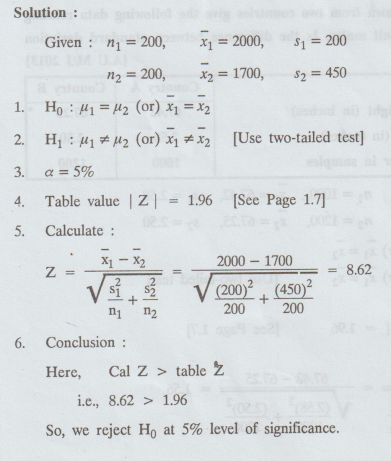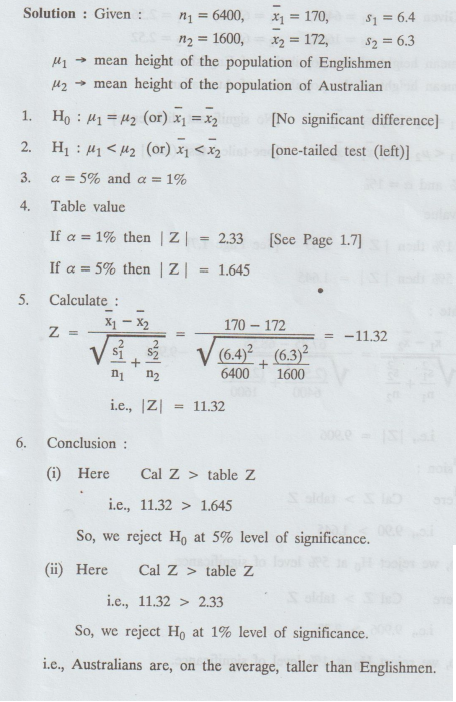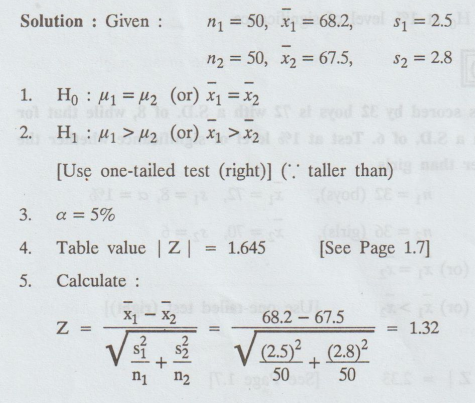Statistics and Numerical Methods: Unit I: Testing of Hypothesis
Large sample test (Normal distribution) for difference of means
Working Procedure, Steps, Solved Example Problems | Testing of Hypothesis | Statistics
Consider two different normal populations with mean μ1 and M2 and S.D σ1 and σ2 respectively. Let a sample of size n1 be drawn from the first population and an independent sample of size n2 be drawn from the second population.
Large sample test (Normal distribution) for difference of
means :
Consider
two different normal populations with mean μ1 and M2 and
S.D σ1 and σ2 respectively. Let a sample of size n1
be drawn from the first population and an independent sample of size n2
be drawn from the second population. Let ![]() be the mean of the first
sample from the first population and
be the mean of the first
sample from the first population and ![]() be the mean of the second
sample from the second population. If the sample sizes are large, we know
be the mean of the second
sample from the second population. If the sample sizes are large, we know ![]() is a normal variate with mean μ1 and
is a normal variate with mean μ1 and
Variance σ21 / n1 is an independent normal variate with mean µ2 and variance
σ22
/ n
Therefore,
the difference  of the two independent normal variates
of the two independent normal variates ![]() and
and ![]() is also independent normal variate. Hence the standard
normal (x1-x2)-E (x1-X2)
is also independent normal variate. Hence the standard
normal (x1-x2)-E (x1-X2)

Now,
set the hypothesis H0 : µ1 = µ2 (there is no
significant difference between the sample means).

Thus,
under H0, the test statistic becomes Z =  which can be
tested at any level of significance.
which can be
tested at any level of significance.
Note
1.
If the samples have been drawn from the 2 distinct populations with common s.d σ,
then under the null hypothesis the above test

which
can be tested at any level of significance.
Note
2.
If the common s.d o is not known, then its estimate based on the sample
variances s21 and s22 can be
obtained as 
In
this case the test statistic becomes

Note
3.If
σ21 ≠ σ22 and σ1 and σ2
are not known, then they can be estimated from the sample variances as σ21
~ s21 and σ22 ~ s22
In this case the test statistic becomes

required
level of significance.
Working
Procedure :
Concerning
two means, with known variances σ1 and σ2.
For
the large samples (n1, n2 > 30) to test the hypothesis
for difference of means, whether μ1-μ2 = δ constant = 0 or
not.
1.
Null hypothesis H0 : μ1 = μ2
(r)ds.r
slomsx3
2.
Alternative hypothesis H1: μ1 ≠ μ2
(or)
H1
μ1 > μ2 (or) H1: μ < μ2
The
application of one-tailed or two-tailed test depends upon the nature of the
alternate hypothesis.
The
choice of the appropriate alternative hypothesis depends on the situation and
the nature of the problem concerned.
For
example:
Suppose,
there are two brands of tyres, one manufactured by standard process with mean
life μ1 and the other manufactured by new technique with mean life μ2
Two-tailed
test : If our test is whether the tyres differ significantly, then H0 μ1
= μ2 and H1: μ1 ≠ μ2
One-tailed
test (left) : If our test is the tyres produced by the new process have a
higher average life, then H0 : μ1 = μ2 and
H1 = μ1 < μ2
One-tailed
test (right): If your test is the tyres produced by the new process is
inferior, then H0 : μ1 = μ2 and H1
: μ1 > μ2
3.
Level of significance: ɑ
4.
Critical region:
(a)
μ1 ≠ μ2 [two-tailed test]
(b)
μ1 < μ2 [one-tailed test (left)]
(c)
μ1 > μ2 [one-tailed test (right)] 10
5.
The test statistic:

6.
Conclusion :
(a)
If -Zɑ/2 < Z < Z ɑ/2, then we accept Ho; otherwise,
we reject Ho
(b)
If Z < Zɑ, then we accept H0; otherwise, we reject H0.
(c)
If - Zɑ < Z, then we accept H0; otherwise, we reject H0
Example
1.2b(1)
Examine
whether the difference in the variability in yields is significant at 5% level
of signification for the following:

Example
1.2b(2)
The
means of two large samples of 1000 and 2000 members are 67.5 inches and 68.0
inches respectively. Can the samples be regarded as drawn from the same
population of standard deviation 2.5 inches? [A.U M/J 2012]
Solution:
Given:

Example
1.2b (3)
Random
samples drawn from two countries give the following data relating to the
heights of adult males. Is the difference between standard deviation
significant? [A.U M/J 2013]

6.
Conclusion:
Here,
Cal Z < table Z
i.e.,
1.56 < 1.96
So,
we accept Ho at 5% level of significance.
Example
1.2b(4)
The
sales manager of a large company conducted a sample survey in two places A and
B taking 200 samples in each case. The results were in the following table.
Test whether the average sales is the same in the two areas at 5% level. [A.U.
N/D 2013]

Solution
:

Example
1.2b(5)
A
simple sample of heights of 6,400 Englishmen has a mean of 170 inches and a
standard deviation of 6.4 inches, while a simple sample of heights of 1600
Australians has a mean of 172 inches and a standard deviation of 6.3 inches. Do
the data indicate that Australians are on the average taller than Englishmen
?MU [A.U. N/D 2007]
Solution:

Example
1.2b (6)
A
sample of heights of 6400 Englishmen has a mean of 67.85 inches and a S.D of
2.56 inches, while a sample of heights of 1600 Australians has a mean of 68.55
inches and a S.D. of 2.52 inches. Do the data indicate that Australians are on
the average taller than Englishmen?ted) stealbai atch sd of adoni [TOOS QUA]
[A.U. N/D 2007] [A.U N/D 2019 R-17]
Solution:

Example
1.2b(7)
In
a random sample of size 500, the mean is found to be 20. In another independent
sample of size 400, the mean is 15. Could the samples have been drawn from the
sample population with S.D 4?
Solution
:

Example
1.2b(8)
The
average marks scored by 32 boys is 72 with a S.D. of 8, while that for 36 girls
is 70 with a S.D. of 6. Test at 1% level of significance whether the boys
perform better than girls.dolla
Solution:

Example
1.2b(9)
The
mean height of 50 male students who showed above average participation in
college athletics was 68.2 inches with a standard deviation of 2.5 inches;
while 50 male students who showed no interest in such participation had a mean
height of 67.5 inches with a standard deviation of 2.8 inches. (a) Test the
hypothesis that male students who participate in college athletics are taller
than other male students. (b) By how much should the sample size of each of the
two groups be increased in order that the observed difference of 0.7 inches in
the mean heights be significant at the 5% level of significance. [A.U N/D 2016
(R13)]
Solution:

6.
Conclusion :
Here
Cal Z < table Z
i.e.,
1.32 < 1.645
So,
we accept H0 at 5% level of significance.
We
conclude that the college athletes are not taller than other male students.
(b)
The difference between the mean heights of two groups, each of size
n
will be significant at 5% level of significance if Z ≥ 1.645.

Hence,
the sample size of the two groups should be increased by atleast 78 50 = 28, in
order that the difference between the mean heights of the two groups is
significant.

Example
1.2b(10)
Two
samples drawn from two different populations gave the following results:

Test
the hypothesis, at 5% level of significance, that the difference of the means
of the population is 35.
Solution:

6.
Conclusion :
Here
Cal Z < table Z
i.e.,
1.9 < 1.96
So,
we accept H0 at 5% level of significance.
Example
1.2b(11)
A
sample of 100 bulbs of brand A gave a mean lifetime of 1200 hours with a S.D.
of 70 hours, while another sample of 120 bulbs of brand B gave a mean lifetime of
1150 hours with a S.D. of 85 hours. Can we conclude that brand A bulbs are
superior to brand B bulbs ?
Solution:

6.
Conclusion:
Here Cal Z > table Z
i.e.,
4.79 > 2.33
So,
we reject Ho at 1% level of significance.
Example
1.2b(12)
The
sales manager of a large company conducted a sample survey in states A and B
taking 400 samples in each case. The results were in the following table. Test
whether the average sales is same in the 2 states at 1% level. [1201
bolist-[A.U. M/J 2013] [A.U A/M 2017 R-13]

Solution:

6.
Conclusion:
Here Cal Z > table Z
i.e.,
8.82 > 2.58
So,
we reject H0 at 1% level of significance.
Example
1.2b(13)
A
mathematics test was given to 50 girls and 75 boys. The girls made an average
grade of 76 with a SD of 6, while boys made an average grade of 82 with a SD of
2. Test whether there is any significant difference between the performance of
boys and girls. [A.U N/D 2012 R-08, A.U M/J 2016 R-13]

Solution
:

6.
Conclusion:
Here,
Cal Z > Table Z
i.e.,
6.82 > 1.96
So,
we reject H0 at 5% level of significance.
Example
1.2b(14)
Test
the significance of the difference between the means of the samples, drawn from
two normal populations with the same S.D. from the following data :

Solution:

6.
Conclusion :
Here,
Cal Z > table Z
i.e.,
3.43 > 1.96
So,
we reject Ho at 5% level of significance.
i.e.,
The two normal populations, from which the samples are drawn, may not be same
mean, though may have the same s.d.
EXERCISE 1.2.(a) and 1.2(b)
Tests based on Normal distributions for means and difference of
means.
1.
A sample of 900 items has mean 3.4 and standard deviation 2.61. Can the sample
be regarded as drawn from a population with mean 3.25 at 5% level of
significance ?
Ans.
|z| = 2.67
2.
An automatic machine fills tea in sealed tins with nan weight of tea 1 kg and
S.D 1 gm. A random sample of 50 tins was examined and it was found that their
mean weight was 999.50 gms. Is the machine working plovige properly?
Ans.
|z| = 3.54
3.
A sample of 1000 students from Madras University was taken and their average
weight was found to be 112 pounds with a S.D of 20 pounds. Could the mean
weight of the student in the population be 120 pounds.
Ans.
|z | = 12.66
4.
The average income of persons was Rs. 210 and with Rs. 10 for S.D. in a sample
of 100 people of city. For another sample of 150 people the average income was
Rs. 220 and S.D of Rs. 12. Test whether there is any significant difference
between the average income of the locality.
5.
In a survey of buying habits, 400 women shoppers are chosen at random in super
market 'A' located in a certain section of the city. Their average weekly food
expenditure is Rs. 250 with a S.D of Rs. 40. For 400 women shoppers chosen at
random in super market 'B' in another section of the city, the average weekly
food expenditure is Rs. 220 with a S.D. of Rs. 55. Test at 1% level of
significance whether the average weekly food expenditure of the two populations
of shoppers are equal.
6.
The average hourly wage of a sample of 150 workers in a plant 'A' was Rs. 2.56
with S.D. of Rs. 1.08; The average wage of a sample of 200 workers in plant 'B'
was Rs. 2.87 with a S.D of Rs. 1.28. Can an applicant safely assume that the
the hourly wages paid by plant 'B' are higher than those paid by plant 'A'?
7.
The mean produce of wheat of a sample of 100 fields comes to 200 kg per acre
and another sample of 150 fields gives the mean of 220 kg. Assuming the S.D of
the yield at 11kgs for the universe, test if there is a significant difference
between the means of the samples.
8.
The means of two large samples of sizes 2000 and 1000 are 68.0 and 67.5 gms
respectively. Can the sample be regarded as drawn from the same population of
S.D 2.25 gms.
9.
In a certain factory there are two independent processes of manufacturing the
same item. The average weight in a sample of 250 items produced from one
process is found to be 120 ozs with a S.D of 12 ozs. While the corresponding
figures in a sample of 400 items from the other process are 124 and 14. Find
the S.E of difference between the two sample means. Is this difference
significant? Also find the 99% confidence limits for the difference in the
average weights of items produced by the two processes respectively.
Statistics and Numerical Methods: Unit I: Testing of Hypothesis : Tag: : Working Procedure, Steps, Solved Example Problems | Testing of Hypothesis | Statistics - Large sample test (Normal distribution) for difference of means
Related Topics
Related Subjects
Statistics and Numerical Methods
MA3251 2nd Semester 2021 Regulation M2 Engineering Mathematics 2 | 2nd Semester Common to all Dept 2021 Regulation
